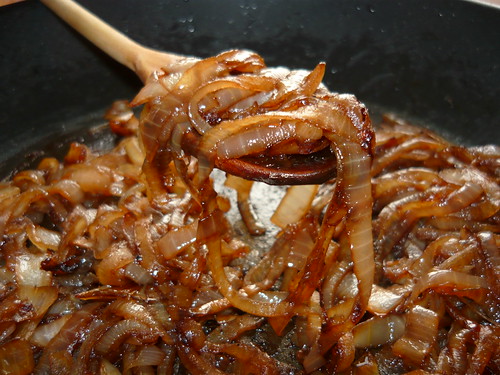Caramelized is commonly used to described the browning of onions (i.e. caramelized onions), the searing of meats, and the tops of baked goods like bread and cheesecake. Contrary to what you may have heard, these are all incorrect usages of caramelize. WHAT!?!! Read on, my friends, read on...
(source)
Now, if you were to refer to the top of that delectable-looking creme-brulee as caramelized, you would be using caramelize correctly. If you were to describe the browning of sugar that occurs when you make caramel syrup, like this:
You would be using 'caramelize' correctly.
Still don't get it? Well, I'll give you a hint...
In creme brulee and caramel syrup, the only thing that you are browning is sugar.
(source)
Do you remember sugars? If you need a refresher, I wrote a post about carbohydrates (i.e. sugars) awhile ago (convenient link).
Sugars are made up of a few select atoms. These are carbon, oxygen, and hydrogen. When you heat them, they start breaking down into smaller molecules, and they release a variety of gases (carbon monoxide, carbon dioxide, hydrogen gas, oxygen gas, water vapor (dihydro-oxygen gas, if you will). Eventually you can brown your sugar to black - and then it's just carbon solid. You've essentially released all the hydrogen and oxygen from it and it looks like something the fiance and I plan to cook chicken with this evening:
(source)
But, breads have sugar, right? So why isn't browning bread a form of caramelization?
That, my friends, is the right question.
Breads, meats, even onions have sugar in them or on their surfaces...but they also have protein. The protein is the key to the difference between browning and caramelizing.
So, you know that sugars have carbon, oxygen, and hydrogen. Well, proteins have the same components, plus one more: nitrogen. Every protein has nitrogen, in the form of an amino group, at the very end of the chain of amino acids that makes up the protein. This amino group can react with the end of sugars to make a sugar-amine (like 'glucosamine', maybe you've heard of it in conjuction with joint health?). These molecules can only form in the presence of heat, so maybe I should put out there right now that apples, avocados, and tuna turning brown when exposed to air are a completely different set of reactions.
The name of the sugar-amine reactions are called Maillard reactions after this guy:
Cute, eh? He can come over and brown my onions any day...
The product of these Maillard reactions are complex sugar-protein polymers that lend a brown color and interesting tastes to the dish. This is why browned bread, browned onions, and browned meat don't really taste alike. They each have distinct sugar and protein components that lend to their sugar-amine complexes, and they give each food a unique taste.
It turns out that Maillard reactions are much preferred to caramelization as far as your palate is concerned. I can imagine that there are some stringent caramel lovers out there who are shaking their heads at me right now. Just hear me out...just like caramelizing a sugar too long will lead to something akin to charcoal briquets, caramelizing is associated with giving foods a slightly bitter taste if taken too far. On the other hand, Maillard reactions get more and more complex as the food browns. What I'm saying is that the margin for error on browning your onions is a lot more forgiving than browning your sugar crust on your favorite custard treat.
I'm actually a terrible hypocrite because I refuse to use the correct nomenclature when I'm talking about browning vs. caramelizing...because the waiter at the restaurant is going to give me the correct thing if I ask for my onions OR my custard to be caramelized...and he will likely not appreciate a lecture on the complexities of the Maillard reactions while he takes my order. On the other hand, you, my fair friends, are a wonderful audience :)
Happy weekend!





Cute blog! It's always great to meet another Iowa blogger (I live in Ames). You now have another subscriber. :)
ReplyDelete